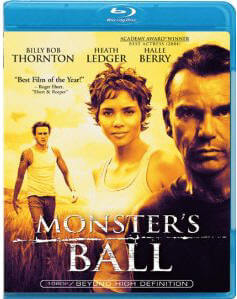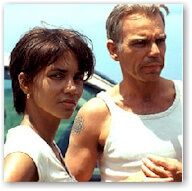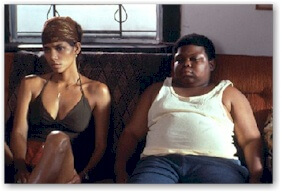Monster’s Ball
Film Reviewed by Yemi Toure
l Monsters (2001)
Monsters (2001)
Click to Order via Amazon
MPAA: Rated R for strong sexual content, language and violence.
Runtime: 111
Country: USA
Language: English
Certification: USA:R
Movie Reviewed, by Yemi Toure Editor, HYPE
If movies could be convicted of a crime, this one would be on Death Row.
OK, "Monster’s Ball" is beautifully shot. And the music is haunting in this tale of race, sex, violence and twisted lives in a small town in post-Sixties Georgia. And yes, there is some great acting by Halle Berry, Billy Bob Thorton, P.Diddy and newcomer Coronji Calhoun. And yes, Halle Berry shows her breasts in the infamous sex scene — more on that later.
But even with all of that, the writers of the script should be charged with a crime for the way they created the lead Black female character Leticia, played by Berry. She is written to be as weak as a wet paper bag, so weak that you wonder if there isn’t some twisted white male fantasy about Black women going on here.
For one thing, Berry’s character Leticia is horribly insulted to her face by her white boyfriend’s father, an insult involving sex and race, but Leticia does nothing about it but storm out of a house.
For another thing, she found out that her white boyfriend (Hank) had been exceedingly dishonest with her: He was a prison officer who directed the execution of her husband — and he never tells her! His silence is morally indefensible, and he did not pay any price for this gross dishonesty to this Black woman, which continued throughout the film — and she did not require anything of him for that crime when she finally found out.
This weakness even carries over into the sex scene you have heard so much about. In the middle of it, the scriptwriters had Leticia say to Hank, "I want you to make me feel good". She says it more than once. So even in the midst of the most talked-about scene in the film, Leticia is still written to be dependent on someone else — even for a good screw.
 Oh — about those boobies: They aiight. The scene could have worked just as well without exposing them.
Oh — about those boobies: They aiight. The scene could have worked just as well without exposing them.
On her way to the top of her game, Berry has exposed her breasts in two films, this one and "Swordfish". Does she worry about what others think? In one interview, Berry says: "Without sounding flip or rude, I don’t really care".
Well, Halle, flip the script:
Julia Roberts is at the top of HER game, and she has exposed her breasts not at all to get there. Not even in "Pretty Woman", where she played a prostitute. Not even in the bathtub scene.
And that reminds me — in "Monster’s Ball", there are two women who expose their breasts — Leticia and a white prostitute.
Hmmmmmm.
What understanding did these white scriptwriters have of Black life? If you are Black and poor and female, like Leticia, and you are down and out and alone, who do you call on? Your family, your community, your Creator. But as writer Rori Blakeney points out, in "Monster’s Ball" the scriptwriters created a character who has no extended family around her. A character who does not turn to her community for help. A character whose husband was executed and whose son was killed and who is about to get evicted from her place, and who only turns to a white male for aid.
It’s the white-male-as-savior syndrome again.
At four different points in the film, Leticia is without a car, and is out on the street in the small town and in need of a ride. The script has Hank just happening to drive by — not once, not twice, not three times, but all four times. What an easy out for the scriptwriters. What a poor plot for us.
Also, the writers have Hank’s son dead and buried before the family cleans up his blood from the living room furniture. Excuse me?
 By this time, the script has turned into a pile of crap. Some in the audience I saw it with were sitting in what seemed like stunned silence. Some — including me — were hissing and tsk-tsking at the screen.
By this time, the script has turned into a pile of crap. Some in the audience I saw it with were sitting in what seemed like stunned silence. Some — including me — were hissing and tsk-tsking at the screen.
And don’t get me started about the use of the n-word. In one tense scene, Hank uses the term against a fellow prison guard. That’s real. No problem with that. But the Black guard says nothing about it, does nothing about it. Does Hank later pay any price for this? None.
And it gets deeper.
Hank, Leticia’s boyfriend, likes to eat chocolate ice cream with a white plastic spoon. What’s the big deal, you ask? On a movie set, nothing is accidental; everything has to be selected. So do we have some race and color symbolism at work here in the chocolate ice cream and the white spoon?
As writer Blakeney points out, "chocolate ice cream and a plastic spoon could possibly represent the fact that Hank always wanted a Black woman. In other words, the spoon serves as a phallic symbol that is always dipping into the chocolate."
The race game even shows up in that old symbol of the good guys in the white hats.
Leticia’s Black husband is executed, and she later hocks her wedding ring at a pawn shop, runs right across the street to another shop and uses the money to buy her white boyfriend a white cowboy hat.
We got that message: Destroy the Black male, get rid of any memory of him, take what you have left and use it to pump up the white male.
All that color and race symbolism is deep. Where is psychiatrist Frances Cress Welsing when we need her? And where can you get tools to analyze these films?
You think these writers have little appreciation of only Black folx? Even white females don’t survive the scriptwriters’ slash and burn.
There are three main white females: The white prostitute. The unseen white grandmother who committed suicide. The unseen white mother who is spoken of so badly. And none of them are likable characters.
This film is not for kiddies. There is a graphic execution by electric chair, an explicit suicide, the death of a child, more than one soul-less sex scene. Characters are emotionally and physically abusive. We don’t want our children to learn to smoke and drink, but those habits are shown here as normal and acceptable. The film barely avoided getting an NC-17 rating.
So why were there so many children in the Atlanta theater where I saw this — even 4-, 5- and 6-year olds? Because so many adults brought them.
Not all the crimes were on the screen.
On the surface, this flick is about sex, race, crime and violence. Underneath, it is about sex, race, crime and violence. What are the tools that while males use to maintain their supremacy? Sex, race, crime and violence.
By the end of the film, the Black male is dead, the Black female has lost her husband, her son and her house, and she has been thoroughly walked on by the white male, and the white male is eating that chocolate ice cream with that white spoon, and even feeding it to the helpless and child-like Black female.
If this film had announced during the opening credits, "This is a film about white male supremacy," they would not have had to change a single thing to fulfill that declaration.
By the closing credits, the only one still standing and not dependent is the white male.
And that’s a crime.

Read More AALBC.com Film Reviews
